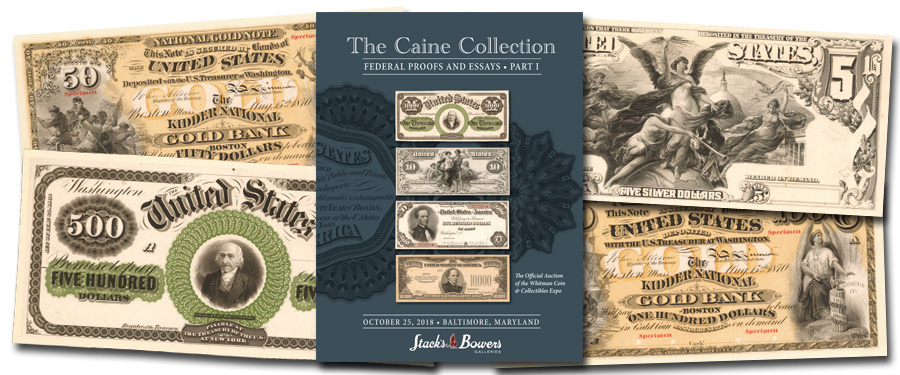
Welcome
to Part 1 of the Caine Collection of federal currency proof notes, an
unprecedented offering. Such proofs, also called essays, represent the
evolution of designs that in most instances were used in this form or modified
to create regular series, from those of 1861 onward in the large-size series,
continuing into the post-1928 small size.
The
proofs range from full face and reverse impressions in full color, some with
000000 serial numbers, to design elements such as portraits and counters.
In the
world of collecting paper money, proofs are the rarest of the rare. Even the
most available proof issue in the Caine Collection is a rarity in an absolute
sense. Many are absolutely unique and others are one of just two or three
known.
In
their time, proofs were mostly used internally within the Treasury Department
currency office in the Treasury Building in Washington, later in the separate
Bureau of Engraving and Printing facility. An exception to the internal-use
rule was made in 1862 when Secretary of the Treasury Salmon P. Chase sent a
large number of proofs to Alexandre Vattemare in Paris, the details of which
are related in the story of Vattemare given in the present catalog.
Other
proofs passed to the engravers and artists, to Treasury officials, and others
whose families eventually placed them into the hands of numismatists. In our
recent August sale of Part II of the Joel R. Anderson Collection we showcased a
regular-issue $50 “Technicolor” Gold Certificate that had been given to
President Theodore Roosevelt. In the sister field of stamp collecting, the
personal collection of President Franklin D. Roosevelt, including stamps made
to his order, were sold on the open market. The provenances of most proof notes
were never recorded, and thus much fascinating information has been lost. We do
have, however, many auction and other sale records from recent decades.
Among
the highlights of proofs in the Caine Collection are full plate impressions as
well as design elements from the famous “Educational Note” series of the 1890s,
most famously from 1896, but with some proofs bearing other dates from 1891 to
1897. Many of these came from the remarkable collection of Harry W. Bass, Jr.
that we cataloged and sold in 2011, never thinking that we would handle these
treasures again.
In
creating this listing I worked from an initial file created by Matt Quinn, in
many instances taking from some of the descriptions we did years ago, such as
for the Bass Collection notes. Others were new to Matt and me and involved new
research and exploration. I particularly enjoyed writing about Alexandre
Vattemare and might even do a book on him someday!
The
term “rarest of the rare” is often used in our catalogs, especially when famous
coins or rare varieties are offered. Most such coins are expensive, say over
the $100,000 line. Not so with the Caine Collection proofs. “Rarest of the
rare” applies to many that we estimate in just four figures. Opportunity is
also applicable. I never know when a rarity or unique item will pass through
our hands again, but many are off the market for generations. Just about any
proof in the Caine Collection is sufficiently rare that a decade or generation
can pass between offerings. Accordingly, opportunity is at your
fingertips now, but may not be in the future.
We are
delighted and honored to present the Caine Collection—not even closely
approached by any other collection of federal proof notes ever to cross the
block.
Thank
you for your interest and participation.
Q.
David Bowers





